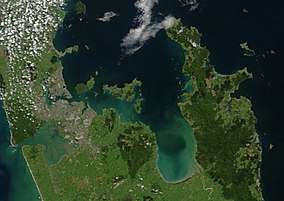Mercury Islands
The Mercury Islands are a group of seven islands off the northeast coast of New Zealand's North Island. They are located 8 kilometres (5 mi) off the coast of the Coromandel Peninsula, and 35 kilometres (22 mi) northeast of the town of Whitianga.
| Maori: {?} | |
|---|---|
 A true-colour image acquired by NASA's Terra satellite, on 23 October 2002. The Mercury Islands are just visible at top right, to the northeast of the Coromandel Peninsula. | |
| Geography | |
| Coordinates | 36°35′S 175°55′E |
| Administration | |
Description
The main chain of the Mercury Islands consists of the large Great Mercury Island (also known as Ahuahu) to the west, Red Mercury Island (Whakau) to the east, and five much smaller islands between the two (Korapuki, Green, Atiu/Middle, Kawhitu/Stanley and Moturehu/Double Islands). Only the main island is inhabited – the others form part of a nature reserve. To the south of this chain numerous tiny islets lie to the north of the mouth of Mercury Bay. One lone island, Cuvier Island, lies 15 kilometres (9.3 mi) to the north of Great Mercury Island, although this island is not normally considered part of the Mercury Island group. Great Mercury Island is what remains of a Pliocene rhyolitic volcano.
Great Mercury
Great Mercury Island is owned by Michael Fay and David Richwhite, prominent New Zealand businessmen. The private island, which features two luxurious residences, can be hired for around $20,000 NZD per day. U2's lead singer Bono and guitarist The Edge stayed on the island during U2's Vertigo concerts in Auckland in November 2006. On 30 November 2009, Great Mercury Island hosted the first successful launch of Rocket Lab's suborbital Atea-1 sounding rocket.[1]
Fay and Richwhite have spent $750,000, matching the same amount contributed by the Department of Conservation, to make the island (which is open to the public) pest-free, in a programme beginning in 2014.[2] On 13 May 2016 it was announced that the Greater Mercury group of islands are now free from introduced mammalian pests.[3]
Other islands
The smaller islands in the group have been identified as an Important Bird Area by BirdLife International because they provide nesting sites for up to 3000 breeding pairs of Pycroft's petrels.[4] Moturehu/Double Island and Whakau/Red Mercury are home to the critically endangered Mercury Islands tusked wētā.
See also
References
- "NZ's First Space Launch Saved By $6 Replacement Part". New Zealand Herald. 30 November 2009.
- Michael Fox, "Private Funding Sways Conservation Decisions", The Dominion Post, 9 June 2014, p. 2.
- "Pest-free islands jewel in Coromandel crown". stuff.co.nz. Retrieved 14 May 2016.
- BirdLife International. (2012). Important Bird Areas factsheet: Small Mercury Islands. Downloaded from http://www.birdlife.org on 2012-02-02.
External links
- 'Geology – New Zealand's Geological History', from An Encyclopaedia of New Zealand, edited by A. H. McLintock, originally published in 1966. Te Ara – The Encyclopedia of New Zealand, updated 2006-09-26. Accessed 2007-04-15.